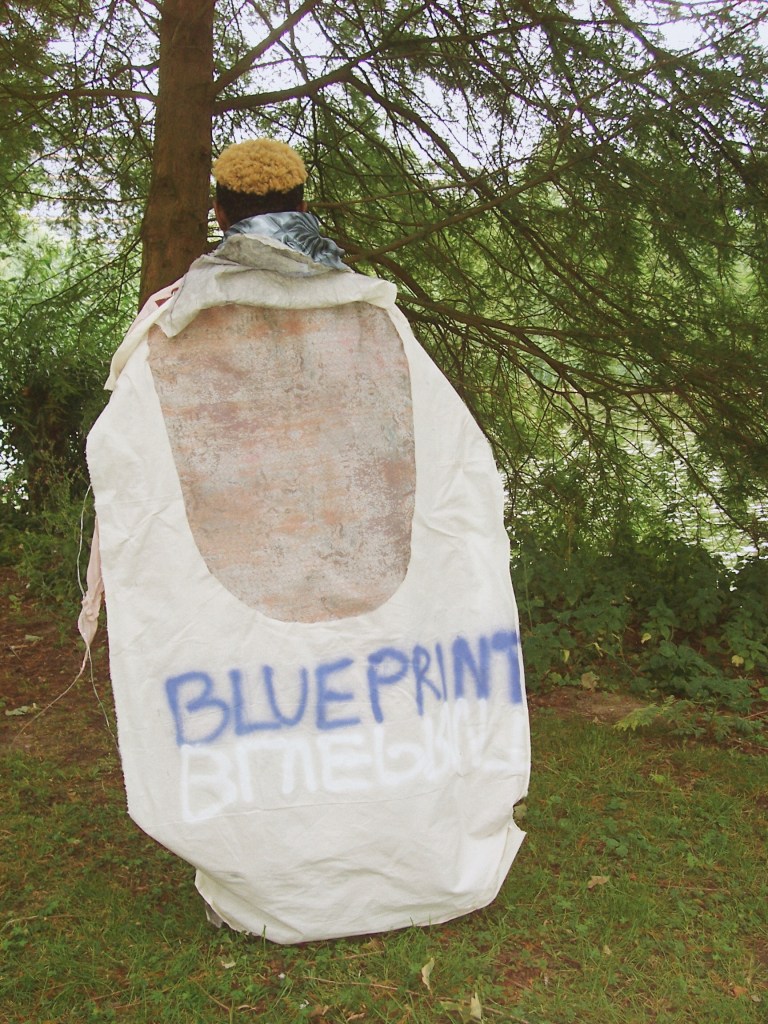Blueprint to Uniformity
Amsterdam, Netherlands
Summer 2019
Blueprints are plans of attack that are meant to be followed when creating new designs in most creative fields; especially in architecture. These blueprints are also “negatives” of the original sketches and plans of the designs. By using negative in a connotative sense, specific themes were played with to try to represent the overall negative reputation that the Biljmermeer, the Zuidoost borough in Amsterdam, retains as being poorly designed and a ghetto for non-Dutch people. Through this design process the creators of this piece experienced first-hand what it’s like to envision a blueprint, in this case designs for a garment, only to be hit with the reality of limited time, parameters, and materials. This reflects similarly to how the Bijlmermeer was envisioned as a modernist utopia for middle class Dutch citizens, but then molded into a haven for Surinamese people in the 1970s. In a way, this project broadcasts the battle of blueprint vs. reality.









Inspired by the surroundings of the Bijlmermeer estates, specifically the graffiti, clothing wires, and the overall color pallets of the Bijlmer area, the artists of this piece wanted to visually represent the space and the surroundings through the garment. The dinginess of the garment represents the façade of the Bijlmermeer, also how the Biljmermeer resembles known ghettos in Eastern United States. By using spray-paint, dyes, paper, and other textiles, a wearable collage was created that embodies the Bijlmermeer in the eyes and minds of the artists. Subtle details in the construction came to specific ideas. The map inside represents how the Bijlmer was envisioned, versus how the building and space was created/ received, which the outside of the garment symbolizes.
Inspired by the surroundings of the Bijlmermeer estates, specifically the graffiti, clothing wires, and the overall color pallets of the Bijlmer area, the artists of this piece wanted to visually represent the space and the surroundings through the garment. The dinginess of the garment represents the façade of the Bijlmermeer, also how the Biljmermeer resembles known ghettos in Eastern United States. By using spray-paint, dyes, paper, and other textiles, a wearable collage was created that embodies the Bijlmermeer in the eyes and minds of the artists. Subtle details in the construction came to specific ideas. The map inside represents how the Bijlmer was envisioned, versus how the building and space was created/ received, which the outside of the garment symbolizes. Pins in the garment represent small areas of unification and connection in the Biljmer; and in the community: such as restaurants and other businesses from residents of the Bijlmer area. The main theme of this project is uniformity, and trying to deviate from the pre-designed notions and ways of living not limited to the Bijlmer, but all of society. In the video, the park bench represents the monotony of daily life in a designed setting like the Bijlmermeer; not eliminating the clips of ambient noises and civilian traffic. Uncomfortable pauses represent space and time in of daily life and the things that happen that we may, or may not, experience.




Pins in the garment represent small areas of unification and connection in the Biljmer; and in the community: such as restaurants and other businesses from residents of the Bijlmer area. The main theme of this project is uniformity, and trying to deviate from the pre-designed notions and ways of living not limited to the Bijlmer, but all of society. In the video, the park bench represents the monotony of daily life in a designed setting like the Bijlmermeer; not eliminating the clips of ambient noises and civilian traffic. Uncomfortable pauses represent space and time in of daily life and the things that happen that we may, or may not, experience.

In collaboration with Matthew Kelley
Copyright © 2023 | Philip Gabriel Steverson
